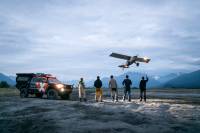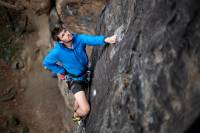Marmot West Rib Parka Review: 35 Days in Alaska
During the spring climbing season in the Alaska Range, I had the opportunity to test out Marmot’s West Rib Parka, one of the biggest, thickest parkas I’d ever seen.
My trip encompassed a personal climbing trip out to Mt. Huntington, followed by a 25-day patrol with Denali Climbing Rangers. I patrolled the West Buttress route on Denali as a volunteer for the Denali Rescue Volunteers program.
This was the perfect trip to put the West Rib Parka through the wringer: over 35 days on a glacier during the spring climbing season in Alaska.
In short: The Marmot West Rib Parka ($600 MSRP) proved warm for my extended stay in Alaska’s high ranges, and I only had a few grievances.
The Trip
For the first part of our trip, two friends and I flew into the East Fork of the Tokositna Glacier. We set up a base camp for 10 days at the base of the west face of Mt. Huntington. Less-than-ideal weather allowed us only two climbing outings and many more days at our base camp.
For the second part of the trip, I geared up with the Denali Climbing Rangers to accompany them on a 25-day West Buttress search-and-rescue patrol. This was part of the Denali Rescue Volunteers program.
Our itinerary was to spend about a week going up from base camp to the 14,000-foot camp before spending 10 days acclimatizing there. We would then push to a 17,000-foot camp, followed by a successful summit day thanks to the fantastic weather during this spring Denali season.
I had the chance to use the West Rib Parka for all 25 days of the patrol. I was pleasantly surprised with the West Rib‘s comfort and warmth but found a few shortcomings. Below are my thoughts after spending 35 nights in the West Rib Parka.
Marmot West Rib Parka Review

Specs and Features
The Marmot West Rib Parka has a Pertex Quantum ripstop nylon outer shell guarding overlapping 3M Thermal R 40g synthetic insulation. It has an interior panel of 3D WarmCube 800-fill goose down. The square WarmCube baffles prevent down from shifting. This combination of a down interior and a synthetic outer layer protects the down from wetting out in damp conditions. Marmot designed this system to provide a balance of water resistance and packability.
A generous cut is designed to be the outer layer for winter outings, and Marmot sizes the hood to go over a helmet. But it has a cinch cord to perfect the fit with or without a helmet. An included stuff sack helps make the West Rib compact in a climbing bag and allows you to clip it to a harness during technical climbs.
The West Rib Parka has two sizeable zippered handwarmer pockets and two extremely spacious zippered chest pockets accessed from the exterior. Two interior mesh drop-pockets fit a pair of gloves, a Nalgene, or anything else to be kept warm.
I found the spacious handwarmer pockets and the large-volume chest pockets extremely useful. I kept odd necessities in the chest pockets, such as an extra pair of sunglasses, a headlamp, a battery pack, or a small camera. They disappeared into the lofty structure of the jacket and stayed warm and protected while remaining easy to access.

The double-pull center zipper allowed me to zip up from the bottom to access my belay loop — a favorite feature. However, I found the choice of zipper disappointing on the West Rib Parka. The small zipper pull would always snag on the draft tube and was finicky. This was worse with cold hands or gloves.
I found the hybrid insulation felt like a synthetic jacket but slightly lighter and more packable. This was due to the inner down 3D WarmCube panels. We were in predominantly below-freezing temperatures, so I didn’t experience any truly wet conditions to test the water resistance of the outer synthetic layers.
However, I predict this parka would fit well in a Pacific Northwest climbing environment. The generally damp conditions and technical ice routes with dripping water could thoroughly wet out a down jacket.
Comfort and Warmth

The West Rib Parka is designed as a belay parka for winter alpine/ice climbing and mountaineering. It’s meant to be layered over climbing apparel.
The generous cut of the West Rib achieved this fit well and still offered a reasonable range of movement. I found this parka exceptionally warm for the conditions on technical ice routes on Mt. Huntington and the 20,310-foot Denali West Buttress route summit.
While ice climbing in the shade in low double-digit temperatures on Mt. Huntington, it was always a reprieve throwing on the Marmot West Rib. I was engulfed in warmth while waiting at the belay. On the West Buttress of Denali, we had an unseasonably warm and clear season. I didn’t get the chance to test the parka in full-storm conditions. However, I was never cold at a 17,000-foot camp in single-digit temperatures during the coldest parts of our trip.
I found the outer Pertex Quantum shell excellent at shedding wind on the few days we had windy conditions. Aside from the small main zipper, my only other wish for the parka was a slightly longer cut in the back (I am 6 feet tall, 150 pounds) to cover more of my hips.
Weight, Durability, and Packability

Coming in at a verified 1 pound 14.3 ounces in unisex medium, the West Rib Parka isn’t one of the lighter belay parkas. It is heavier than full-down parkas but more packable than full-synthetic parkas. The West Rib strikes a nice balance of packability and weight while offering increased performance in wet environments.
The interior and exterior fabrics are much thicker than on ultralight parkas, adding to the overall weight. However, this delivered peace of mind that the jacket would not snag, tear, or otherwise rip easily during climbing outings involving sharp rock or ice tools.
Throughout all my testing of the Marmot West Rib Parka, I never noticed any snags or tears in the fabric on either side. This is despite shouldering ice tools or climbing mixed pitches in the parka.
Marmot West Rib Parka: Conclusion

Designed to encounter any wet or cold conditions in the high alpine, the Marmot West Rib Parka is an excellent choice as a quiver-of-one jacket. It was light and packable enough for single-day outings and versatile and roomy enough for true expedition-style climbing or wet environments.
The generously sized pockets provide ample space to keep any belongings easily accessible. And the helmet-compatible hood and double-zippered main zipper fared well for technical climbing objectives.
The West Rib Parka could be improved with a larger, less finicky front zipper. It was frustrating when trying to zip up the jacket with gloves or cold hands, and it detracted from the overall quality and usability. And for me, a longer tail would have been appreciated.
Despite these drawbacks, I was generally impressed with the West Rib Parka’s warmth, comfort, and features. And its durability never left me questioning its ability to endure harsh conditions.
The post Marmot West Rib Parka Review: 35 Days in Alaska appeared first on GearJunkie.



